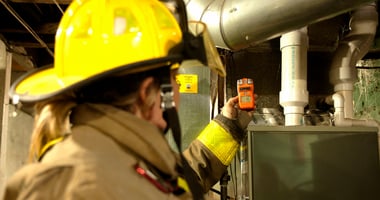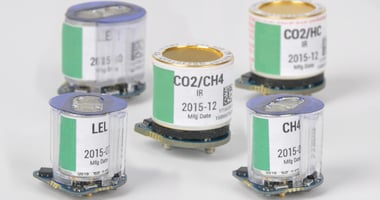What is the difference between carbon monoxide and carbon dioxide? If you confuse the two, you’re not alone. You’re probably aware that they are two different gases—but which one is the good one and which is the bad one? Is it even correct to classify them that way? Before getting into how and where carbon monoxide (CO) and carbon dioxide (CO2) affect people and the environment and how to test for them, let’s get a basic understanding of where they come from.
Both gases are a combination of carbon and oxygen, which is why their names are similar. But these gases are created through different chemical reactions.
Where Does Carbon Dioxide Come From?
Carbon dioxide is the result of complete combustion. Complete combustion is a chemical reaction in which a hydrocarbon reacts with oxygen to produce carbon dioxide and water. Complete combustion often (but not always) involves a flame. You’re witnessing complete combustion when you watch a candle burn: candle wax is a hydrocarbon, which reacts with oxygen in the air and the heat from the lit wick. The carbon dioxide is released into the air as a colorless and odorless gas. It is a largely non-reactive gas, and once released, it quickly mixes throughout the atmosphere.
Carbon dioxide is also produced through industrial processes. Industrial plants that produce hydrogen or ammonia from natural gas, coal, or large-volume fermentation operations are some of the largest commercial producers of carbon dioxide. Carbon dioxide has many applications in the food and beverage industry, including carbonating drinks.
Where Does Carbon Monoxide Come From?
Carbon monoxide, on the other hand, is the result of incomplete combustion. Incomplete combustion happens when there is a limited supply of air, so only half as much oxygen adds to the carbon, forming carbon monoxide (CO = one oxygen atom, CO2 = two oxygen atoms).
Unlike carbon dioxide, carbon monoxide does not occur naturally in the atmosphere. It is created through the incomplete combustion of coal, natural gas, and oil. Low levels of oxygen and low temperatures lead to carbon monoxide in the combustion mixture.
Dangerous levels of carbon monoxide can be produced by any fuel-burning appliance, including gas furnaces, gas stoves, gas dryers, gas water heaters, fireplaces, and cars. As a colorless and odorless gas, you can’t identify it without gas detectors.
In industrial settings, the internal combustion engine is the chief source of carbon monoxide. Many furnaces and ovens produce large amounts of the gas, especially when they are not maintained properly. Truck drivers, forklift operators, or people working near this type of equipment are at a higher risk of exposure. Workers near or within enclosed areas or confined spaces such as manholes, garages, tunnels, loading docks, warehouses, vehicle repair shops, and splicing vehicles are also at risk.
While carbon monoxide is usually an unwanted by-product, packaged carbon monoxide is used in a variety of industries including metal fabrication, chemical manufacturing, pharmaceuticals, electronic and semiconductor applications, and for reducing ores when manufacturing metal carbonyls.
Health Risks for Carbon Monoxide and Carbon Dioxide
While carbon dioxide poisoning is rare, a high concentration of it in a confined space can be toxic. Excess carbon dioxide uses up space in the air instead of oxygen, creating an environment for asphyxiation. Symptoms of mild carbon dioxide poisoning include headaches and dizziness at concentrations less than 30,000 ppm. At 80,000 ppm, CO2 can be life-threatening. As a reference, OSHA (Occupational Safety and Health Administration) has set a CO2 permissible exposure limit (PEL) of 5,000 ppm over an eight-hour period and 30,000 ppm over a 10-minute period.
Carbon monoxide is a far more dangerous gas. Also referred to as the “Silent Killer,” carbon monoxide is a colorless, odorless, tasteless, and non-irritating gas, so the early signs of poisoning are difficult to detect. The Centers for Disease Control and Prevention estimate that more than 50,000 people in the U.S. are hospitalized for symptoms of carbon monoxide poisoning, while over 430 people die annually from the gas.[3]
Carbon monoxide is so dangerous because it binds to the parts of your blood that carry oxygen molecules, so it chemically blocks your body and organs from getting the oxygen it needs. The current OSHA permissible exposure limit (PEL) for carbon monoxide is 50 ppm averaged over eight hours — much lower than the PEL for carbon dioxide. The exposure level considered immediately dangerous to life and health (IDLH) is 1500 ppm.
Using Gas Detectors to Measure Carbon Monoxide and Carbon Dioxide
When it comes to choosing an industrial gas detector for the workplace, a single-gas carbon monoxide detector will not measure carbon dioxide levels, nor does it work the other way around. The sensors are specific for each gas. The good news is you have several options when it comes to the best gas detector for monitoring carbon monoxide and/or carbon dioxide, including personal single-gas monitors, multi-gas monitors, and area monitors. The most important factor in choosing the right instrument is that you understand the environment and properties of the gas or gases you’ll be monitoring.
[2] https://whatsyourimpact.org/greenhouse-gases/carbon-dioxide-emissions



